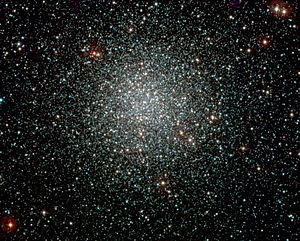NGC 3201
| Kugelsternhaufen NGC 3201 | |
|---|---|
 | |
| Aufnahme durch das MPG/ESO-2,2-m-Teleskop | |
| AladinLite | |
| Sternbild | Segel des Schiffs |
| Position Äquinoktium: J2000.0, Epoche: J2000.0 | |
| Rektaszension | 10h 17m 36,7s [1] |
| Deklination | -46° 24′ 40″ [1] |
| Erscheinungsbild | |
| Konzentrationsklasse | X [2] |
| Helligkeit (visuell) | 6,8 mag [3] |
| Winkelausdehnung | 18,2′ [3] |
| Physikalische Daten | |
| Integrierter Spektraltyp | F6 |
| Rotverschiebung | 0,001649 ± 0,000001 [4] |
| Radialgeschwindigkeit | 494,0 ± 0,2 km/s [4] |
| Geschichte | |
| Entdeckung | James Dunlop |
| Entdeckungsdatum | 1. Mai 1826 |
| Katalogbezeichnungen | |
| NGC 3201 • C 1015-461 • GCl 15 • ESO 263-SC26 • Dun 445 • GC 2068 • Bennett 44, Caldwell 79, Melotte 99, h 3238 | |
NGC 3201 ist ein Kugelsternhaufen im Sternbild Segel des Schiffs am Südsternhimmel, der etwa 16.000 Lichtjahre von der Sonne entfernt ist und einen Durchmesser von rund 80 Lichtjahren aufweist. NGC 3201 hat einen Durchmesser von 18,2′ und eine scheinbare Helligkeit von 6,8 mag. In ihm stieß ein Forscherteam vom Institut für Astrophysik der Universität Göttingen mit Hilfe des Präzisionsspektrografen MUSE, auf ein Schwarzes Loch von rund 4,4 Sonnenmassen.[5][6]
Das Objekt wurde am 1. Mai 1826 von James Dunlop entdeckt.[7]
Weblinks
- Standout stars(engl.)
- Photometry Results (Memento vom 26. September 2007 im Internet Archive)
- Globular Cluster Database
- Astronews.com: Bild des Tages 23. Januar 2018
Einzelnachweise
Auf dieser Seite verwendete Medien
Autor/Urheber: Roberto Mura, Lizenz: CC BY-SA 3.0
Caldwell Catalogue objects.
Autor/Urheber: ESO, Lizenz: CC BY 4.0
Colour-composite image of the globular cluster NGC 3201, obtained with the WFI instrument on the ESO/MPG 2.2-m telescope at La Silla. Globular clusters are large aggregates of stars, that can contain up to millions of stars. They are among the oldest objects observed in the Universe and were presumably formed at about the same time as the Milky Way Galaxy, in the early phase after the Big Bang. This particular globular cluster is located about 16 000 light-years away towards the Southern Vela constellation. The data were obtained as part of the ESO Imaging Survey (EIS), a public survey being carried out by ESO and member states, in preparation for the VLT First Light. The original image and astronomical data can be retrieved from the EIS Pre-Flames Survey Data Release pages, where many other nice images are also available.


